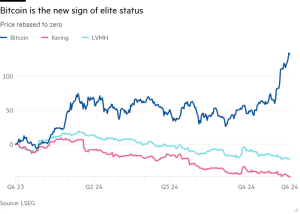Can the private sector deliver Labour’s housebuilding boom?
Labour’s dream of building 1.5mn homes has a problem: it relies on Britain’s commercial housebuilders to deliver them.
While the industry has welcomed the goal of building more homes than at any point in two generations as “bold” and “vital”, regulators and industry experts say their dominant interest is to control supply and keep up prices.
“Housebuilders do not want lower prices,” housing experts Toby Lloyd, Neal Hudson and Rose Grayston — now an adviser to housing minister Matthew Pennycook — wrote in a report for the Joseph Rowntree Foundation this year.
“Maintaining headline sales prices is . . . important for housebuilders seeking to keep market sentiment and profit rates up — even if this means selling fewer homes in the short-term,” they added.
This dynamic played out last year. The seven largest listed builders of homes for private sale, who together account for about a third of new homes, cut their output by about a fifth.
And they increased average selling prices by 2 per cent, compared with a decrease of 1.4 per cent for overall UK house prices, according to the Office for National Statistics.
Taylor Wimpey chief executive Jennie Daly defended the strategy of “optimising pricing” on an earnings call with the Financial Times late last year.
FT Edit
This article was featured in FT Edit, a daily selection of eight stories to inform, inspire and delight, free to read for 30 days. Explore FT Edit here ➼
“We are not flooding the market. We are not delivering more homes than the market can absorb. It’s a very careful balance,” she said. “What it’s not trying to do is artificially hold price.”
Housebuilders argue they do not have a free hand to set prices.
They say new home prices are determined on the one hand by the wider housing market, and on the other by the price of land, materials, labour; the burden of the planning system; and the profit margin they need to earn as commercial entities.
Only one out of 50 housebuilding companies surveyed by Knight Frank this month said Labour could meet its 1.5mn target. “Builders can only build if buyers can buy,” the Home Builders Federation, the industry group for housebuilders, said this month.
By setting out a sweeping package of reforms to Britain’s sclerotic and capricious planning system, Labour has started work on removing one of the key barriers to increasing housing supply.
But the stubbornly high price of new build housing puts the government in a bind. Though it has promised more funding for social housing, any money will be limited by the tight fiscal constraints facing chancellor Rachel Reeves as she presents her first Budget next week.
Without a big change in affordable supply, Labour needs the private sector to build about 200,000 homes a year to hit its average annual target of 300,000 — or 1.5mn homes over five years — according to Savills.
“That looks basically impossible,” said Emily Williams, a research director at Savills, who found the private sector has not produced 200,000 homes annually since the 1960s, when the market was radically different.
The National Housing Federation, which represents affordable housing providers, and the HBF recently warned the government was on track to miss its five-year target by almost a third.
“There is a tension,” Williams said. “We can say there is a ‘need’ for more than 300,000 homes a year. But the question is who is in the position to buy those homes. You are looking at the difference between ‘what is the need’ and ‘what is the market capacity’.”
The limits of the market
Labour’s promise to deliver more homes was a key plank of its electoral platform, at a time when discontent with unaffordable housing is hitting record highs across advanced economies.
The current picture is dire. The number of first time buyers has hit a 10-year low, rents are rising to record levels, homelessness and temporary accommodation costs are spiralling, and more than 1.2mn households are on waiting lists of social housing in England.
Supply is well below target. England added 234,400 net additional dwellings — the key measure of housing supply — in the year to March 2023.
Planning reforms, unveiled by deputy prime minister and housing secretary Angela Rayner over the summer, have been welcomed by the industry. The government has promised more funding for overstretched planning offices. The housing market is also slowly recovering as interest rates fall, with companies planning to modestly boost their output over the next two years.
But experts warn this will not be enough.
The Resolution Foundation said in a paper last month: “Even if planning reform delivers a dramatic ramping up of planning approvals, this does not guarantee that these will automatically convert to homes being physically built.”
The Ministry of Housing, Communities and Local Government said planning reforms were “the first tangible steps towards making sure everyone has access to a decent, safe and affordable home in which to live”. They added that the government “expects developers to play their part too”.
Big commercial housebuilders all have stockpiles of land where planning permission has already been granted. Just four large companies together were sitting on nearly 150,000 sites with detailed planning consents as of the end of 2023, according to their financial reports.
The spectacle of housebuilders apparently hoarding planning approvals and drip-feeding supply to maintain their selling prices has led to criticism of the industry and accusations of anti-competitive behaviour.
In 2022 former Conservative housing secretary Michael Gove called the big developers a “cartel”, and urged the UK competition watchdog to investigate the market.
The Competition and Markets Authority’s resulting study, released in February this year, largely blamed the undersupply of housing on the planning regime, and on the fact that the UK relies too much on these speculative private developers in the first place.
“Housebuilders’ incentives lead them to build more slowly than they could do, with the objective of maximising sale prices and keeping their stock of built and unsold homes to a minimum,” the CMA said.
“Private housebuilders do not collectively have the necessary incentives to build houses at the rate required to meet policymakers’ objectives.”
The watchdog flagged issues in the industry, including poor build quality and a lack of innovation — and is investigating information sharing among eight big developers. But it cleared the housebuilders of large-scale anti-competitive practices that hold back housing supply.
Developers do offer incentives like free upgrades to carpets and kitchens, but headline price cuts are rare.
Substantial price reductions would not only infuriate customers who have previously bought new homes nearby, but could also push their mortgages into negative equity and knock local house prices.
A boost to housebuilding
Can anything be done to break this deadlock? The market balance has been steady for at least half a century, Savills found, with new homes making up a tenth of all property sales.
The only policy that has shifted this 10 per cent limit was Help to Buy, Savills said. The Tory’s decade-long scheme for first time buyers provided loans to help those with small deposits buy a new build.
Housebuilders are lobbying the government to boost demand with a similar programme. “The lack of affordable mortgage availability means more support for buyers is needed,” the HBF said recently.
The other obvious way to boost overall demand is for the government to pay for more affordable housing.
The previous postwar UK housebuilding boom was fuelled by massive construction by local authorities — but this has dwindled since the 1980s and now accounts for only a few thousand homes a year.
Pat McAllister, professor of real estate at Henley Business School, said housing associations — non-profits that build and run affordable housing — had “proven capacity and experience” with development and “would seem the logical organisations” to deliver more homes.
Private companies, like housebuilder Vistry, are also increasingly interested in building on behalf of affordable housing providers.
Reeves is expected to announce a new 10-year settlement for social rent increases, at 1 per cent higher than inflation, which will help to mend housing associations’ battered finances. But she may struggle to find enough cash to be transformative for housing associations within the stretched UK Budget.
Longer term solutions
The government’s “new towns” could help deliver thousands of extra homes, but are unlikely to start being built in large numbers within five years.
A 2018 report by former Tory minister Sir Oliver Letwin recommended planning changes to encourage a more diverse mix of types of housing on each site — including more rental homes.
And there are more radical proposals circulating for how to shake up housing supply outside the traditional channels.
The public sector could take a more active role in the land market, bringing together land to assemble housing sites at a lower cost — using planning measures and compulsory purchase powers. Modular construction methods could speed up building and slash costs.
This would also help overcome supply chain and labour-force constraints that will start to bite if housebuilding expands as much as Labour hopes.
For now, the CMA concluded, housing policy is trying to bridge the gap between a private sector that caters to the market-led “housing demand” and policymakers judgment of the country’s much larger “housing need”.
Cara Pacitti, senior economist at the Resolution Foundation, said the question for the government is “whether you see the state intervening in the market to solve this mismatch . . . to build at a pace faster than the private sector is able to build, or willing to build — depending on who you believe”.
Data visualisation by Amy Borrett
#private #sector #deliver #Labours #housebuilding #boom








